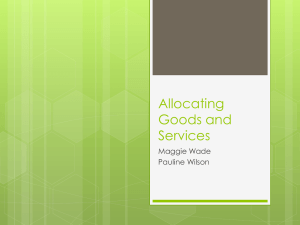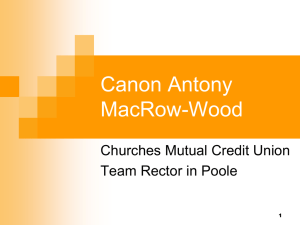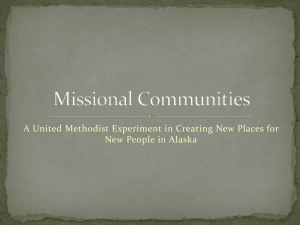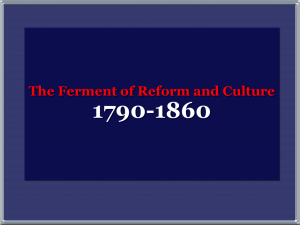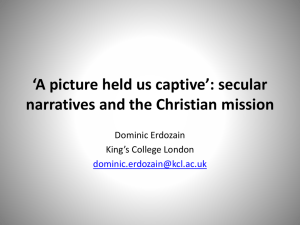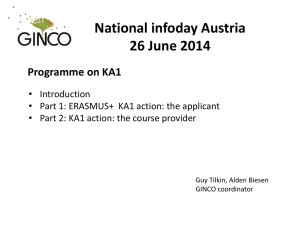Different forms of organisation in local churches
advertisement
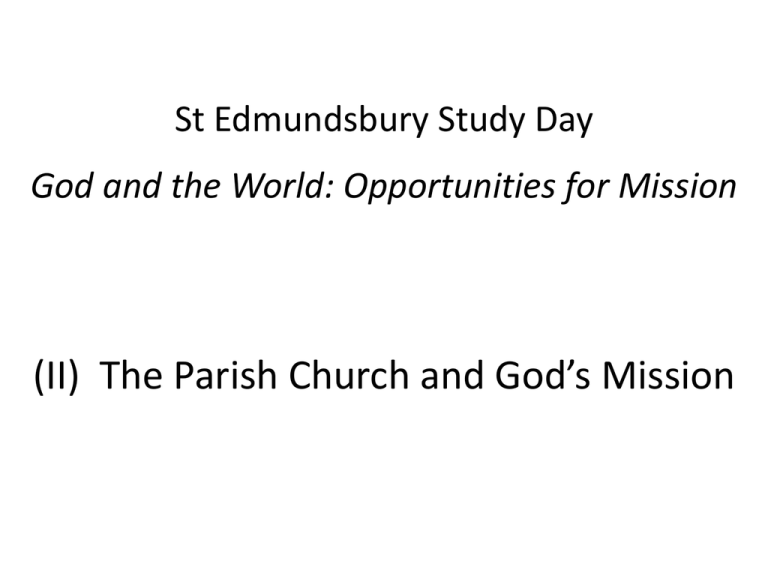
St Edmundsbury Study Day God and the World: Opportunities for Mission (II) The Parish Church and God’s Mission (i) Models of the Church-in-mission (ii) Different Forms of Organisation (iii) Matching up Models with Forms (becoming a sacrament of mission) (iv) Application to Parish Churches This CartoonChurch.com cartoon by Dave Walker originally appeared in the Church Times. (i) Models of the Church-in-mission Stephan B. Bevans and Roger P. Schroeder, Constants in Context: A Theology of Mission for Today (Maryknoll, NY: Orbis Books, 2004) Four contemporary models of the church-inmission - A model is a stylised representation of an authentic tradition The four models thread their way through all theological and denominational traditions, but with varying emphases in different traditions and in different local churches While churches often express two or three of them one will be predominant. Which is it for your church? (i) Mission as proclamation of Jesus Christ as universal saviour - the Salvationist An emphasis on proclaiming the death of Christ as the means of salvation out of this world and into the safety of the gathered church ‘the proclamation of the historical, biblical Christ as Saviour and Lord, with a view to persuading people to come to him personally and so be reconciled to God’ (Lausanne Covenant 1974 para 4) (ii) Mission as ‘liberating service of the reign of God’ - the Liberationist Emphasises social and political praxis in the world to free people from all that enslaves them: salvation as ‘liberation from everything that oppresses man’ (Paul VI, Evangelii Nuntiandi 9) insisting that this includes every aspect of the human person, including openness to the divine. (33). (An older version of this approach: the Established Church serving society as a kind of ‘public utility’ for the rites of passage – christening, marrying and burying everyone in the community) (iii) Mission as participation in the mission of the Triune God (missio Dei) - the Trinitarian drawing inspiration from word ‘missio’ - originally used to describe relationships within the Trinity, esp. how the Father ‘sends’ the Son and the Holy Spirit to the world (cf. Romans 8.3) - an overflowing of God’s relationship of love into the world: the missio Dei within which the church is privileged to live and grow… in ever-widening relationship with the world around (ii) Different Forms of Organisation ‘Organizational form can be defined as the legal ownership and constitution under which an organization operates.’ H. Cameron and M. Marashi, Form or Substance in the Learning and Skills Sector: Does Organisational Form Affect Learning Outcomes? London, Learning and Skills Development Agency, 2004, p. 5. Quoted in Helen Cameron Resourcing Mission, SCM 2010 pp.40-41) It affects… 1. the way in which work is co-coordinated and managed 2. the way in which governance structures and processes render an account to stakeholders 3. the ways in which the organization can secure resources 4. the way in which the assets of the organization are protected and managed 5. the way in which the organization can allocate its resources to pursue its mission 6. the ways in which the organization can establish its legitimacy in the eyes of its users Furthermore, Helen Cameron Resourcing Mission (pp.24-37) describes five genres or cultural forms of organisation Most local churches tend to embody one or other: I. Public Utility – provides an essential service; covers the country; no membership but legal officers II. Voluntary Association – definite membership; set procedures for members to run the association themselves; an agreed aim III. Friendship Group – voluntary, informal, aim is fellowship IV. Third Place Meeting – occurs within a public space (eg café, pub), constrained by limits of that space, shared aim which can be changed by agreement V. Network Resource - to support a group of people who already have a shared and stated aim (iii) Matching up the models with these forms A. SALVATIONIST – mission as proclamation of a definite message… to persuade people to make a personal response and come into the gathered church 1. the way in which work is co-ordinated and managed Salvationist • Management: with such a clear aim and objective there will need to be tight control of ‘work’, needing a clear leadership structure providing firm direction and targets… • Assessment: through measuring the number of individuals who respond positively and come into the congregation – a measurable and quantifiable approach, allowing targets to be raised each year… 2. the way in which governance structures and processes render an account to stakeholders Salvationist • through regular and clear communication of the results of the work, giving the numbers of individual responses and so quantifying and measuring progress year on year 3. the ways in which the organization can secure resources Salvationist • through an organised and focused approach (a ‘campaign’ style of fundraising), with increasing momentum and rising pressure on supporters to give more and more so as to broaden the outreach year on year 5. the way in which the organization can allocate its resources to pursue its mission Salvationist • a clear leadership structure will allocate resources in a managed and targeted way to maximise the effectiveness of work and generate a maximum number of responses Salvationist: summing up Which of Cameron’s five cultural forms? …a clear aim; clear set of procedures; depending on a committed membership… Voluntary Association “definite membership; set procedures for members to run the association themselves; an agreed aim” B. LIBERATIONIST - mission as social and political change in the world … to build the kingdom in the local community and beyond 1. the way in which work is co-ordinated and managed • Management: such a general aim and objective implies a loose leadership structure that allows dialogue and collaboration with other groups in society, while still providing overall direction to keep ultimate goal in place… • Assessment: the aim to change people’s lives in physical as well as spiritual ways means that success can only be partially measured and quantified eg. through assessing the impact of a community project… 2. the way in which governance structures and processes render an account to stakeholders Liberationist • through lively communication of the results of the work, by telling the stories of community projects and their impact on people’s lives. Where there is data this will be used, there will also be a need to relay impressions of change. 3. the ways in which the organization can secure resources Liberationist • through partnerships with other groups and local/national government where possible, to secure joint funding for community projects 5. the way in which the organization can allocate its resources to pursue its mission Liberationist • the leadership will need to be flexible in how it allocates resources, depending on where its funding is coming from and what constraints the donors put on the use of that funding (not always easy - sometimes conflicts between donor’s aims and ‘kingdom’ aim). Liberationist: summing up Which of Cameron’s five cultural forms? …providing an essential service, the liberation of all people; partnership with other bodies more important than keeping a defined membership… ? Public Utility “provides an essential service; covers the country; no membership but legal officers” C. TRINITARIAN – mission as entering into personal relationship with God in Christ, and with one another, starting within the church and spreading out in an ever widening circle of giving and receiving… 1. the way in which work is co-ordinated and managed Trinitarian • Management: this unspecific aim implies leadership by example rather than direction, in which Christ-like relationships at the centre percolate out through the congregation into the community. • Assessment: relationships cannot be measured or quantified, so there is no way of objectively assessing this approach. Instead, gaining a broadbased impression of the health and happiness of the church community 2. the way in which governance structures and processes render an account to stakeholders Trinitarian • Telling the stories of those who make up the community, stories which show God in Christ through the Holy reaching out with and through the church to the wider community. 3. the ways in which the organization can secure resources Trinitarian If relationships are good, everyone will contribute to the needs of all, in whatever way they can. Giving will be genuine and spontaneous, which means amounts will fluctuate and be unpredictable. When there is a real need, the necessary resources will be given. 5. the way in which the organization can allocate its resources to pursue its mission The community as a whole will need to come to a common mind, which may take time and during which every voice will need to be heard. The leadership will need to facilitate this process rather than impose its own ideas. Everyone will need to feel included while also recognising that compromises will need to be made. Trinitarian: summing up Which of Cameron’s five cultural forms? … voluntary relationships all important, but no defined membership… relationships are to spread ever outwards into society… aim is definite but cannot be measured Friendship Group “voluntary, informal, aim is fellowship” but with a community-wide vision D. PROPHETIC DIALOGUE Bevans and Schroeder’s fourth model - living within and in dialogue with postmodern culture, in places like cafés, gyms, coffee shops, schools, etc – but also being prophetic in bearing witness to the Kingdom through campaigns for the poor, protest, soup kitchens, community organising, etc. What kind of organisation is implied by this? So what? This analysis shows how different approaches to mission imply different forms of organisation for the local church. One should flow from the other. Integrity in mission will arise when there is this flow… And a church within itself will become a sacrament (an effective sign) of what it is proclaiming which suggests that churches should reform their internal organisation so that they more fully become within what they seek to proclaim without (iv) Application to Parish Churches Which is the predominant form of mission in your own church? How could the organisation of your church be reformed and enhanced in line with this? What steps would you go through to achieve this?
